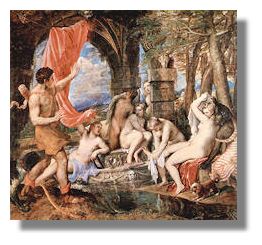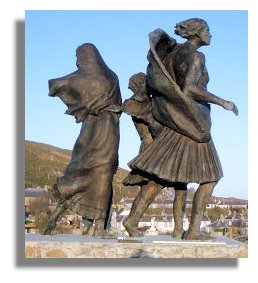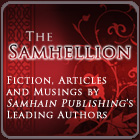 Welcome back to Celtophile Monday! All sources credited. Enjoy!
Welcome back to Celtophile Monday! All sources credited. Enjoy!
Arts/Culture
Art Collection Threatened
The core of the art exhibited at the National Galleries of Scotland are on loan to the collection by the Duke of Sutherland. They include four works by Titian, three by Raphael, an important self-portrait by the Dutch master Rembrandt, as well as works by Rubens and Tintoretto. The Bridgewater Collection, as it is known, is estimated to be worth a billion pounds on the open market and has been with the national collection in Edinburgh since 1945. After a "prudent review" of the family assets, the duke has decided to sell part of the collection. However, after talks with the galleries, he has proposed an arrangement which could see the collection staying in Britain for the next 21 years. But the National Galleries of Scotland, together with the National Gallery in London, will have to raise £50 million by the end of this year to buy Titian's Diana and Actaeon. (From RampantScotland.com)
Scots Language Concerns
The Scottish Language Centre in Perth and Scottish Language Dictionaries, which supports dialects such as Doric, Dundonian and Orcadian, were unsuccessful in securing funding from the Scottish Arts Council (SAC) for next year. They received a total of £158,000 this year, but that funding runs out next April. As a result, concerns have been raised about the future promotion of the Scots language as both organisations could be forced to close unless funding is secured from elsewhere. (From RampantScotland.com)
World Haggis Eating Championship
Competitors from around the globe turned up at the 125th Birnam Highland Games in Perthshire to eat a pound of traditional haggis (made from sheep innards, oatmeal, and spices) in the fastest time. The winner was a local man, Willie Robertson from nearby Dunkeld who downed it all in two minutes and five seconds. Willie won the contest four years ago and walked (staggered?) away with a trophy and a bottle of whisky. One of the contestants, who has been trying for the title for the past three years, is the son of the mayor of Livermore in California. He has vowed not to stop until he wins. The contest is made even more difficult because only plastic knives and forks are supplied - and sometimes they break. A can of beer is provided to aid digestion. (RampantScotland.com)
Preserving Scotland's Military History
An appeal has been launched to allow the trustees of the Black Watch Regimental Museum to buy Balhousie Castle in Perth (seen here), where it is housed. The Ministry of Defence wants to sell the castle and over £3 million is needed to purchase the building and develop it. The castle dates back to the 15th century and in 1962 it became the regimental headquarters of the Black Watch and its regimental museum. The museum does an excellent job of showing the story of the regiment from its founding in 1739, through all the major conflicts in which the Black Watch participated - right up to the present day, when it was merged in 2006 (with the other Scottish regiments) into the Royal Regiment of Scotland, becoming a battalion in that unit. The museum trustees want to expand the facilities to ensure that the history of The Black Watch is preserved for future generations. See Black Watch Appeal for more information.
Dates in Scottish History
September 7 1306 - Sir Simon Fraser, the "Scottish Patriot", who fought alongside Wallace and Robert the Bruce, was executed by the English and his head displayed in London alongside that of Wallace.
September 9 1513 - James IV and the flower of Scotland's nobility were killed in battle at Flodden Field, near Branxton, in the English county of Northumberland.
September 10 1897 - HRH Duke of York opened the Kelvingrove Art Gallery and Museum in Glasgow.
September 11 1297 - Battle of Stirling Bridge, Wallace (as famously portrayed by Mel Gibson in "Braveheart") defeats Edward I.
September 12 1715 - Jacobites defeated government forces at Battle of Sheriffmuir.
September 13 1644 - Battle of Aberdeen, in which the Marquis of Montrose captured the city.
September 14 1745 - Bonnie Prince Charlie, Charles Edward Stuart, occupied Edinburgh.
September 15 1773 - The "Hector" from Loch Broom, near Ullapool, arrives at Pictou, Nova Scotia, carrying emigrants escaping from the "Clearances".
September 16 1859 - David Livingstone discovered Lake Nyasa.
September 18 1818 - Theatre Royal, Glasgow, became the first theatre in Britain to be lit by gas.
September 19 1854 - The Great North of Scotland Railway opened, running from Aberdeen to Huntly.
September 20 1967 - Liner "Queen Elizabeth II" launched at John Brown's shipyard at Clydebank.
Clearances Statue Unveiled A statue, commemorating the tens of thousands of Scots forced to leave their homes during the Highland Clearances, was unveiled last year in Helmsdale, Sutherland. The 10 feet high statue named "Emigrants" shows a man, a boy and a woman carrying a baby departing Scotland and looking ahead to a new future. The aim was to establish a memorial to the victims of the Highland Clearances - and their contribution to the countries in which they settled. Now a copy of that statue has been unveiled, by Scottish Government minister Michael Russell, near the Red River in Winnipeg, Canada, where the Earl of Selkirk settled Scottish families. Named "Exiles" this time, it is said to be the first statue outside of Scotland which commemorates those who left during the Clearances. Further similar monuments are planned in other international locations. (RampantScotland.com)
A statue, commemorating the tens of thousands of Scots forced to leave their homes during the Highland Clearances, was unveiled last year in Helmsdale, Sutherland. The 10 feet high statue named "Emigrants" shows a man, a boy and a woman carrying a baby departing Scotland and looking ahead to a new future. The aim was to establish a memorial to the victims of the Highland Clearances - and their contribution to the countries in which they settled. Now a copy of that statue has been unveiled, by Scottish Government minister Michael Russell, near the Red River in Winnipeg, Canada, where the Earl of Selkirk settled Scottish families. Named "Exiles" this time, it is said to be the first statue outside of Scotland which commemorates those who left during the Clearances. Further similar monuments are planned in other international locations. (RampantScotland.com)
Environment
New Hydro-Electric Project Under Way
The first major hydro-electric power station to be built in Scotland for 40 years reached an important milestone this week when Scotland's First Minister, Alex Salmond, closed a sluice gate to allow the water to build up on the reservoir at Glendoe, near Fort Augustus, above Loch Ness.The bulk of the construction is underground, with the only visible feature being a dam on a reservoir high up in the mountains, to the south of the loch. The drop from the reservoir to the turbines of over 600 metres is the biggest of any UK hydro-electric power station. (From RampantScotland.com)
Fun Stuff
Panoramic Views of Wales
Click here for a scenery-so-lovely-it-makes-you-sigh time waster!
Fell Running
Sound like an oxymoron? It's not! Click here for more about this interesting sport.
Blog of the Week
Island Threads A Western Isles textile artist's notebook.
08 September 2008
Celtophile Monday
at
11:34 AM
![]()
Labels: celtophile monday, Scotophile Monday
Subscribe to:
Post Comments (Atom)





















1 comment:
Fascinating, as always.
Post a Comment